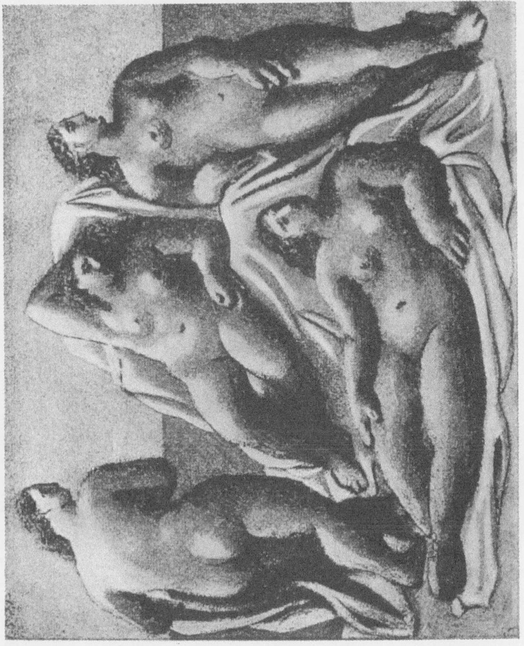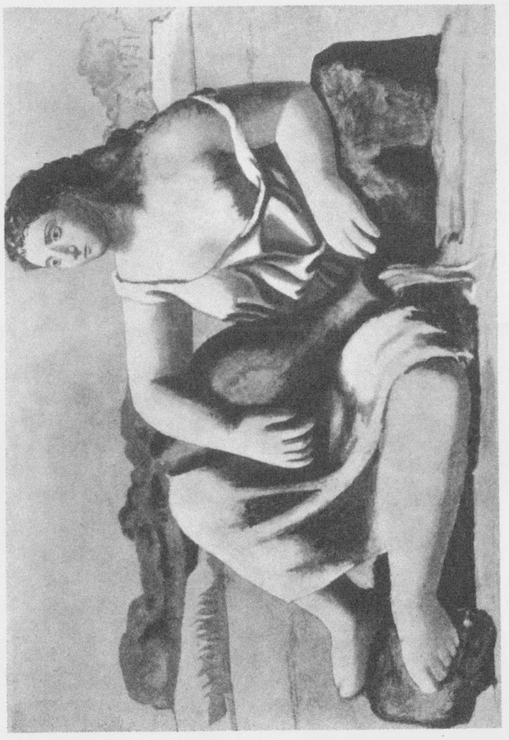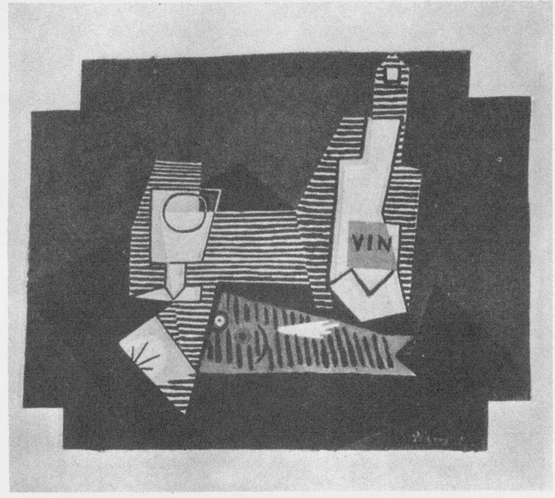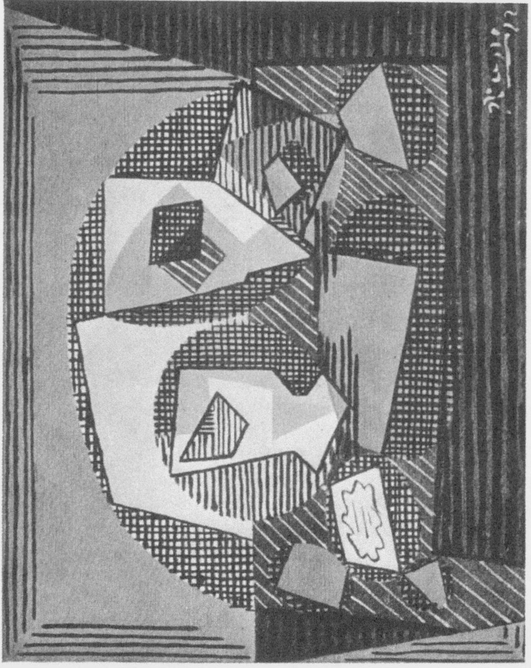It is completely assimilated, of course he is a Spaniard, and a Spaniard can assimilate the Orient without imitating it, he can know Arab things without being seduced, he can repeat African things without being deceived.
The only things that really seduce the Spaniards are Latin things, French things, Italian things, for them the Latin is exotic and seductive, it is the things the Latins make which for the Spaniards are charming. As Juan Gris always said, the school of Fontainebleau was completely a seduction, it was of course completely Latin, Italy in France.
So then the Italian seduction resulted for Picasso after his first visit to Rome in his second rose period which commenced in 1918 with the portrait of his wife and lasted until the portrait of his son in harlequin costume in 1927, and all this began with portraits, then the large women, to end with classic subjects. It was once more Latin seduction this time by means of Italy. But above all it was always and always Spain and it was Spain which impelled him even during this naturalistic period to express himself by calligraphy in his pictures.

37 THE BATHERS (1921)

38 LA SOURCE (1921)
The first thing I saw that showed this calligraphic quality in Picasso were several wood-cuts which he had made during the harlequin period, that first rose period of 1904. There were two birds made in a single stroke and colored with only one color. Beside these two small things I do not remember any other things of his which were really calligraphic until his last period of pure cubism, that is to say from 1912 to 1917.
During this period the cubes were no longer important, the cubes were lost. After all one must know more than one sees and one does not see a cube in its entirety. In 1914 there were less cubes in cubism, each time that Picasso commenced again he recommenced the struggle to express in a picture the things seen without association but simply as things seen and it is only the things seen that are knowledge for Picasso. Related things are things remembered and for a creator, certainly for a Spanish creator, certainly for a Spanish creator of the twentieth century, remembered things are not things seen, therefore they are not things known. And so then always and always Picasso commenced his attempt to express not things felt, not things remembered, not established in relations but things which are there, really everything a human being can know at each moment of his existence and not an assembling of all his experiences. So that during all this last period of pure cubism, 1914—1917, he tried to recommence his work, at the same time he became complete master of his metier. It was the interval between 1914 and 1917 when his mastery of his technique became so complete that it reached perfection, there was no longer any hesitation, now when he knew what to do he could do what he wanted to do, no technical problem stopped him. But after all, this problem remained, how to express not the things seen in association but the things really seen, not things interpreted but things really known at the time of knowing them. All his life this had been his problem but the problem had become more difficult than ever, now that he was completely master of his technique he no longer had any real distraction, he could no longer have the distraction of learning, his instrument was perfected.
At this period, from 1913 to 1917, his pictures have the beauty of complete mastery. Picasso nearly did all that he wanted to do, he put into his pictures nearly nothing that should not have been there, there were no cubes, there were simply things, he succeeded in only putting into them what he really knew and all that ended with the voyage to Italy and the preparation of Parade.
After Italy and Parade he had his second naturalistic period of which anybody could recognise the beauty and his technique which was now perfected permitted him to create this beauty with less effort, this beauty existed in itself.
These pictures have the serenity of perfect beauty but they have not the beauty of realisation. The beauty of realisation is a beauty that always takes more time to show itself as beauty than pure beauty does. The beauty of realisation during its creation is not beauty, it is only beauty when the things that follow it are created in its image. It is then that it is known as beauty on account of its quality of fecondity, it is the most beautiful beauty, more beautiful than the beauty of serenity. Well.
After Italy and Parade Picasso married and in 1918 he left Montrouge for the rue de la Boëtie, he stayed there until 1937 and during this time, 1919 to 1937, there were many things created, many things happened to the painting of Picasso.

39 A BOTTLE OF WINE (1922)

40 STILL LIFE IN OPPOSING COLOURS (1922)
But let us return to calligraphy and its importance in Picasso’s art.
It was natural that the cubism of 1913 to 1917 revealed the art of calligraphy to him, the importance of calligraphy seen as Orientals see it and not as Europeans see it. The contact with Russia, first through a Russian G. Apostrophe as they all called him, and later with the Russian ballet, stimulated his feeling for calligraphy which is always there in a Spaniard always since Spaniards have had for such a long time Saracen art always with them.
And also one must never forget that Spain is the only country in Europe whose landscape is not European, not at all, therefore it is natural that although Spaniards are Europeans even so they are not Europeans.
So in all this period of 1913 to 1917 one sees that he took great pleasure in decorating his pictures, always with a rather calligraphic tendency than a sculptural one, and during the naturalist period, which followed Parade and the voyage to Italy, the consolation offered to the side of him that was Spanish was calligraphy. I remember very well in 1923 he did two women completely in this spirit, a very little picture but all the reality of calligraphy was in it, everything that he could not put into his realistic pictures was there in the two calligraphic women and they had an extraordinary vitality.
Calligraphy, as I understand it in him had perhaps its most intense moment in the décor of Mercure. That was written, so simply written, no painting, pure calligraphy. A little before that he had made a series of drawings, also purely calligraphic, the lines were extraordinarily lines, there were also stars that were stars which moved, they existed, they were really cubism, that is to say a thing that existed in itself without the aid of association or emotion.
During all this time the realistic period was commencing to approach its end, first there had been portraits which ended with harlequins, for once Picasso had almost wished to look at models. The naturalistic painting changed to the large women, at first women on the shore or in the water, with a great deal of movement, and little by little the large women became very sculpturesque. In this way Picasso emptied himself of Italy. That is his way.
During the year 1923 his pleasure in drawing was enormous, he almost repeated the fecondity and the happiness of his first rose period, everything was in rose. That ended in 1923. It was at this time that the classic period commenced, it was the end of Italy, it still showed in his drawings but in his painting he had completely purged himself of Italy, really entirely.
Then came the period of the large still-lifes, 1927, and then for the first time in his life six months passed without his working. It was the very first time in his life.
It is necessary to think about this question of calligraphy, it must never be forgotten that the only way Picasso has of speaking, the only way Picasso has of writing is with drawings and paintings.
1 comment